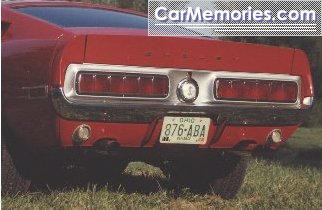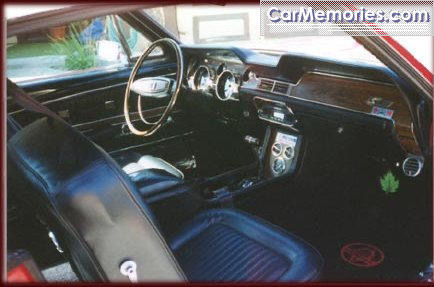1968 Shelby Mustang
The lease was expiring on the two hangers that housed Shelby American At the Venice, California, airport. Sales of Shelby Mustangs were up in 1967, six times more than 1966, promising an even better 1968. More assembly space was going to be needed to build more cars. The increased sales also compounded the problems of obtaining a large enough supply of quality fiberglass to modify the Cars.
A.O. Smith in Ionia, Michigan, was supplying quality fiberglass to gm for its Corvettes. They agreed to make fiberglass parts for the Shelby Mustangs. Shelby American was split into three pieces. The Shelby Racing Company was moved to Torrance, California. The Shelby Parts Company started out in Torrance, California, but was later moved to Michigan and renamed Shelby Autosports. The third piece was to produce the Shelby Mustangs, Shelby Automotive, Inc. It only made sense to move the production facilities to Michigan, Ford was making more of the decisions on what the Shelby Mustang was to be, production decisions and how to sell the cars. A more reliable supplier of quality fiberglass would be much closer. Assembly operations were moved to A.O. Smith's larger facilities in Ionia, Michigan. And Ford owned the name cobra. Shelby Automotive was to be based in Livonia, Michigan.
All 1968 Shelby Mustangs were built in Metuchen, New Jersey, and shipped by rail to Ionia, Michigan. The Shelby add-ons replaced stock Ford pieces, so the cars were shipped minus those body parts.
The 1968 Shelby Cobras were designed by 1967 Shelby buyers. Luxury and comfort were a lot more popular than no frills race options. By compromising the sporty cars of the first two years the car would appeal to a much larger market. And sales were expected to increase. So the 1968 Shelby Mustang was even more of a compromise. There was little competition from Ford or anyone else for gt cars like the Shelby Mustangs so 1968 was expected to be a great year. The 1968 Shelby Cobras were offered as a small block GT350, a 428 GT500 and mid year a Cobra Jet GT500KR. (Read about these models on their respective pages.)
The '68 Shelby Cobras were basically stock Mustang GT's much like the 1967 model. The body of the 1968 Mustang was little changed from the 1967 so only cosmetic modifications were made over the '67 Shelby Mustang. Basically only the front end and the tail were changed and a new Cobra emblem was used.
The hood scoop on the '67 made too much wind noise, so a hood was used with a scoop almost the width of the hood. Two rows of louvers were cut across the top of the hood to allow air to exit through the hood. The rear edge of the hood had a black decal that gave the appearance of opening and exit for air. The hood was held down with a stock Mustang release latch and a pair of Druz fasteners that twisted to lock it in place. The whole front end of the car was fiberglass. The air inlet to the radiator was much larger than the 1967 style. The opening was trimmed in chrome. Shelby had to ask for special permission of the government to do that to the car. Something he had done before. The first '68 Shelby's came with Marchal driving lights inside the opening. After some problems and customer complaints, the Marchals were replaced with Lucas lights. All early '68 Shelby's were recalled and their driving lights exchanged. The side scoops remained with only the top ones functional. A padded roll bar was welded in place with an inertia reel aircraft shoulder harness hooked to it like the 1967 model. Side reflectors were required on all cars by government regulations. The early Shelby's had a rectangular Bezel bolted to the rear quarter panels with a small raised, border around the reflector. Later in the year the panels were flat with oval reflectors. The lips of the fenders were trimmed in chrome strips. The upper and lower side scoops were retained. Some of the lips of the scoops were raised, some weren't. Some cars had both types. At the rear of the car was a molded fiberglass trunk deck lid with an integral rear air spoiler, continued from '67. On the side, on the lower rocker panels were white GT stripes indicating GT350, GT500 or GT500KR.
Off the shelf 1965 Thunderbird taillights replaced the stock Mustang units. Trimmed in chrome, the sequential taillights blinked across what looked like six individual lights. (Years later the all chrome frames became hard to find when Ford offered only the same frame trimmed in black. This was the same frame used on the T-Bird, rather than stock both frames, only the black one was available. This picture on the left has the black frame.) a fiberglass panel was added to support the taillights. The rear valance was stock gt Mustang. Under the valance exited dual exhaust tips with two large pipe-in-a-pipe tail pipe tips. Note the Shelby pop-open gas cap with the Cobra emblem and the letters shelby across the rear spoiler. The letters were also placed across the front of the car, just in front of the hood. (See the picture below.)

Inside the cockpit, the interior was stock GT Mustang. Wood grain veneer graced the doors and the dash. A wood grain console carried a set of Stewart Warner oil pressure and amp gauges to supplement the stock ones in the dash. The padded armrest was embossed with a large coiled snake. The interiors came in black or saddle. Mandatory options were: tilt away steering column, a fold down rear seat, power steering and brakes.
The deluxe interior was all vinyl with custom weave Mustang bucket seats, full loop pile carpet, and electric clock. The center console was custom to the Shelby Mustangs. The tach was an 8,000 rpm with a 140 mph speedometer.

The GT350's were powered with Ford's new 302 4v. Gone was Ford's infamous High Performance 289. The stock engine was rated at 250 hp. An aluminum, high velocity, high volume, Cobra hi-rise manifold handled a Holley 4 barrel carb. The very early cars carried the stock cast iron because the factory couldn't get an ok on the emission tests using the aluminum hi-rise and Holley carb. The Holley was an advanced design cathedral float four barrel. Shelby American did offer a unique option for the small block version. You could get a Paxton supercharger which increased the horsepower by 40% to about 335 horse. Big block horsepower from a small block Ford. For a few dollars more though, the buyer could get a GT500, so very few superchargers were actually installed. The factory offered performance and dress up optional parts like headers, Koni Shocks and shift knobs. Ram air was standard on the GT500KR, an option on the GT350. (See the GT500KR page for more information.) Also on the engines were die cast aluminum Cobra valve covers, chromed oil filler cap and dipstick. The hood was fastened in place with Druz, turn and lock hood locks. The same hood locks were used on the Mustang Mach I's. The cars all came with standard 15"x6" steel, heavy duty steel rims and hub caps. The hub caps were stock Ford Thunderbird and were suppose to look like mag wheels with a Shelby Cobra emblem in the middle. (See the hubcaps on the image below.) The accountants at Ford thought they could save a lot on the 68's by making the aluminum alloy wheels an option, the same type 10-spoke wheel offered at the end of the '67 production run. The 15"x7" wheel was a special Shelby only mag. (The 1968 aluminum wheels will not fit the 1967 cars, though.) The rims carried four-ply polyglass Goodyear high performance tires.
In this picture my GT350 sports the Thunderbird hubcaps
The base model for the Shelby Mustangs was the GT Mustang with heavy duty suspension. But there were some Shelby differences. The coil and 4 leaf springs were special use, unique to the Shelby Mustangs in the '67 & '68 models. The springs were designed to to be more firm as they compressed under stress but still allowed a respectful normal ride. Anti-wind up rear spring dampers were added for better acceleration. The front sway bar was thicker (.94") than the GT Mustang and adjustable, Gabriel shock absorbers replaced the stock ones. The cars came with power-assisted floating caliper front disc brakes and heavy duty rear drum brakes. The brake system was a dual master cylinder with a proportioning valve and low pressure warning light. The power assisted steering had a crisp ratio of 16:1. The rear axle was heavy duty. This year Mustang came with a collapsible steering column and a safety padded center steering wheel.
During the 1968 production year, as usual, changes were made on various things. The early cars received different lower scoops, ones with an extra highlight on the front edge of the scoop. (My GT350 is an early car and actually has '67 scoops.) Some '68 cars came with dual serial numbers. Apparently the plan was to use a numbering system similar to the '67 method. But it wasn't done and the cars numbers got a unique Shelby number at the end of the Ford number. California cars did not have functioning sequential taillights, due to state laws. The other interesting glitch is the door sill plate on the early cars said "Shelby American, Inc." Later cars got a plate saying "Shelby Automotive."
A convertible model was offered for the first time in 1968. Considered in 1967, a prototype was built. It was redone as a '68 even though the serial numbers on the car were '67. This particular car was stolen from Shelby American, stripped, recovered then promptly restored as a '68. This car was used In company brochures and pr materials. The convertible came as a GT350, GT500 and a GT500KR. Unique to the Shelby convertible was a large roll bar with D-rings said to be included to hold a surf board.
So why were these Shelby Mustangs called Shelby Cobras? Production of Cobras had stopped in 1967. Shelby had intentions of building Cobras again. Ford now owned the name Cobra. The desire was to keep the name Cobra out in front of the public. Thus the '68 Shelby Cobra Mustangs were called Shelby Cobras. The word "Mustang" is not found anywhere on the cars.
A side note: a couple of other special interest Fords were also Modified at A.O. Smith. The Dan Gurney XR-7G Cougars with 427 engines and '68 Ford Thunderbirds with power sunroofs were completed there.